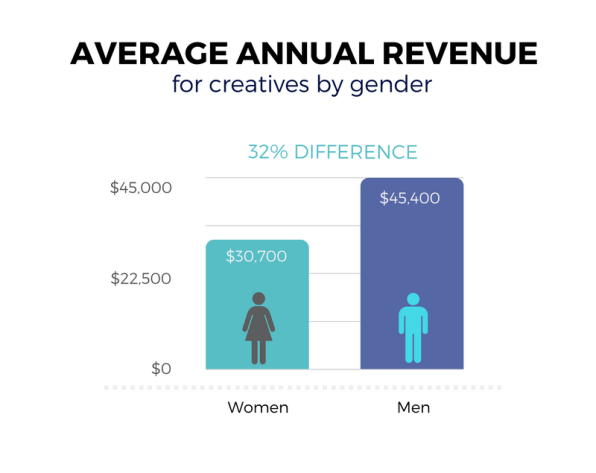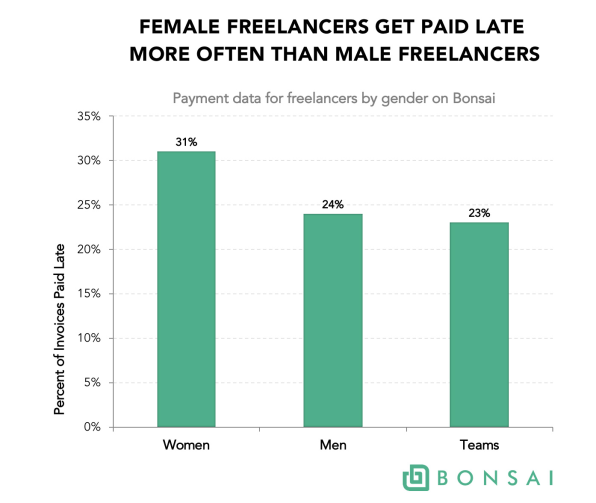The freelance and gig economy was supposed to create a level playing field free from traditional biases and discrimination, but that’s not how things are playing out in reality.
Recent studies have found that women Uber drivers earn 7% less than male drivers, while women freelancers charge lower rates, are more likely to get paid late, and are four and a half times less likely to be earning over $150,000.
Women are still better off working in the freelance and gig economies than the traditional job market—where they earn only 79¢ for every dollar earned by a man (even less for women of color)—but the independent workforce is yet to prove itself gender neutral.
While men out-earn women doing the same job in the freelance and gig economies, however, the gap is far less pronounced, less likely to be a direct product of bias, and according to some experts, should prove much easier to solve than the gender gap in the traditional workforce.
How a gap persists in an unbiased algorithm
When a user requests a lift on a ride-sharing application like Uber, a complex algorithm determines the best driver based on a myriad of factors, none of which have to do with the driver’s gender. Yet when researchers at Uber and Stanford sought to explore whether there was a discrepancy in earnings between men and women, they concluded that the average male driver earned 7% more than his female colleagues.
According to Stanford University economics professor and one of the paper’s coauthors, Paul Oyer, the remaining gap can be explained by a number of factors, the most significant being on-the-job experience. According to their research, drivers that have completed 2,500 trips earn an average of 14% more per hour than those who have completed only 100 trips.
“The more you drive, the better you get at it,” said Oyer, who spent time driving an Uber to see how drivers learn how to maximize their earnings over time. “The difference is men drive more trips per week, they drive more weeks, and they leave the platform less frequently, and as a result they accumulate on-the-job experience faster.”
Learning where to start a shift, which rides to take, and which hours to drive in order to maximize earnings all come with experience, says Oyer, and if the average male driver has more experience, they’re more likely to out-earn the average woman driver. Of course, it might not all be a matter of choice. For example, Pew researchers recently discovered that women are spending more time on both childcare and housework than they have in years past.
Oyer and his fellow researchers also discovered that men tend to drive slightly faster than women, which allows them to pick up more riders and earn more money over the same period of time.
“On the one hand you could look at what we found and say ‘look, men have an advantage, they make a little more money than women on Uber,’” Oyer says. “On the other hand you could say, conditional on where they drive, how fast they drive and how much experience they have, men and women make exactly the same amount. I would say that’s fair.”
Why women freelancers typically earn less than men
Unlike those who work in the gig economy—where unbiased algorithms set earnings rates—freelance workers set their own prices, and those rates can be impacted by the discrepancies that remain prevalent in the traditional economy.
“The remaining consequences of the very prolonged gender pay gap in the traditional employee space are still trickling over into freelancing,” explains Brie Reynolds, FlexJobs‘ senior career specialist.
Reynolds explains that if women have earned 79% of what their male counterparts make in traditional jobs, they are likely to bill the same services at a lower rate because they are setting their rates on what they have earned in the past. In fact, a recent study by HoneyBook found that among independently employed creative entrepreneurs, women earn 32% less than men.

“A woman will pitch herself at a lower rate than a man, which often has to do with their own assumptions about their value, based on their time in an employee job, where they were getting paid less than men doing the same job,” she explains.
Fortunately, Reynolds says there are two solutions to help close this gap. One is simply connecting with other freelancers and independent workers in the field to get a better sense of what others charge for the same services, and which employers to avoid. Her other suggestion is to simply try charging a higher rate for new clients.
“I’ve heard from women who are freelancers who will decide to just pitch a high rate to see what happens, and they pitch it and it gets accepted, no questions asked, and they think, ‘How many years have I been pitching a lower rate when I could have asked for more?” she said.
Why women freelancers are more likely to be paid late
Though he wasn’t looking for a gender gap, Matt Brown found one recently when exploring the factors that lead to late payments. As the CEO of Bonsai, which provides payment services to freelancer, Brown was able to run three years’ worth of invoicing and payment information through an analysis program to determine what factors led to late payments. While there were many that contributed, the study found that invoicing under a typical woman’s name increased the likelihood of late payment by 7%.

“In the back of my mind, I was kind of hoping there wasn’t a story on the male versus female side, because I would like to think freelancing is this next step in the way we work,” he said. Though the study couldn’t pinpoint the exact reason behind this discrepancy, Brown suspects it stems from the client side.
“The client is in such a position of power, they’re a company in most cases dealing with an individual who doesn’t have a lot of recourse if the client pays them late,” he says. “Perhaps the client feels they can take advantage of female freelancers more easily.”
Whatever the cause, Brown’s study also unintentionally stumbled upon a solution. The research found that invoices sent under a woman’s name are paid late 31% of the time, and invoices sent using a male name are paid late 24% of the time, but those that list a team, group, collective or company are only paid late 23% of the time. As a result, all freelancers can benefit from representing themselves as a larger entity, rather than as an individual.
“Rather than marketing yourself as Jane Smith, maybe you want to market yourself as Smith Designs,” says Brown. “By presenting yourself as coming from a larger entity rather than an individual, you can rebound the perception of power with a client.”
Brown adds that the best way to avoid late payments is by screening clients and setting clear expectations before entering an agreement. “If all of your tools to solve this is what to do once it’s already late, you’re playing a losing game,” he said. “The best time to avoid getting paid late is before it happens.”
(66)